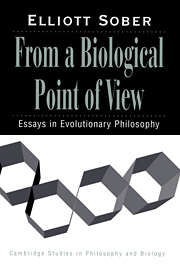Book contents
- Frontmatter
- Contents
- Acknowledgments
- Introduction
- 1 Did evolution make us psychological egoists?
- 2 Why not solipsism?
- 3 The adaptive advantage of learning and a priori prejudice
- 4 The primacy of truth-telling and the evolution of lying
- 5 Prospects for an evolutionary ethics
- 6 Contrastive empiricism
- 7 Let's razor Ockham's razor
- 8 The principle of the common cause
- 9 Explanatory presupposition
- 10 Apportioning causal responsibility
- 11 Evolution, population thinking, and essentialism
- 12 Temporally oriented laws
- Index
10 - Apportioning causal responsibility
Published online by Cambridge University Press: 14 January 2010
- Frontmatter
- Contents
- Acknowledgments
- Introduction
- 1 Did evolution make us psychological egoists?
- 2 Why not solipsism?
- 3 The adaptive advantage of learning and a priori prejudice
- 4 The primacy of truth-telling and the evolution of lying
- 5 Prospects for an evolutionary ethics
- 6 Contrastive empiricism
- 7 Let's razor Ockham's razor
- 8 The principle of the common cause
- 9 Explanatory presupposition
- 10 Apportioning causal responsibility
- 11 Evolution, population thinking, and essentialism
- 12 Temporally oriented laws
- Index
Summary
Is this particle's acceleration due more to gravity or to electricity? Classical physics regards this question as well-conceived. We may answer by examining physical details of the system before us and using our knowledge of pertinent laws. Newton's law of gravity tells us how mass produces a gravitational force; Coulomb's law of electricity shows how charge generates an electrical force. Each of these source laws can be connected with the consequence law “F = ma” to determine which force induces the greater component acceleration.
In this Newtonian case, two questions seem interchangeable: What contribution did gravity (or electricity) make to the particle's acceleration? What difference did gravity (or electricity) make in the particle's acceleration? These questions are simultaneously addressed by investigating two counterfactual questions: How much acceleration would there have been, if the gravitational force had acted, but the electrical force had been absent? How much acceleration would there have been, if the electrical force had acted, but the gravitational force had been absent? Classical particles obey John Stuart Mill's (1859) principle of the composition of causes. The result of the two forces is just the sum of what each would have achieved, had it acted alone. We see what each contributed by seeing what difference each made in the magnitude of the effect.
- Type
- Chapter
- Information
- From a Biological Point of ViewEssays in Evolutionary Philosophy, pp. 184 - 200Publisher: Cambridge University PressPrint publication year: 1994
- 2
- Cited by

